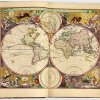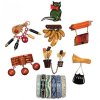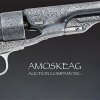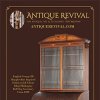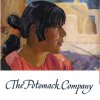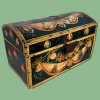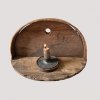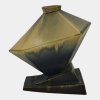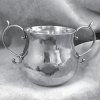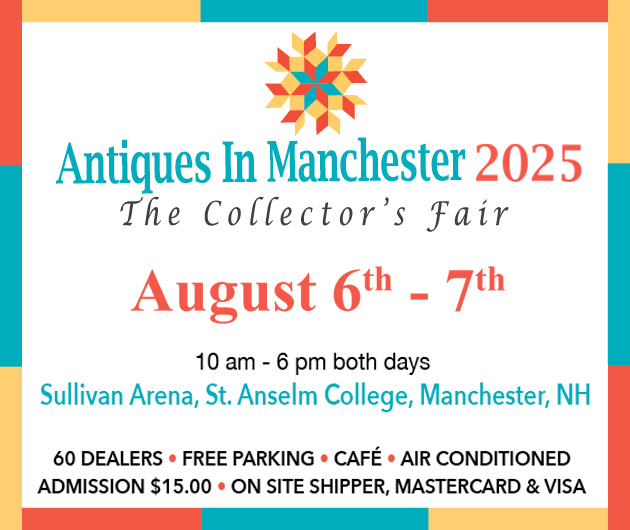Solid Sales at Rago and Skinner
February 14th, 2016
Antique Jewelry & Gemology
Photos courtesy Rago Arts and Skinner, Inc.
A great deal of anticipation preceded Rago Arts’ December 6, 2015, jewelry sale in Lambertville, New Jersey, where bidders vied for Dora Jane Janson’s coveted collection of Art Deco and Art Nouveau jewelry, which realized a total of $579,063 (with buyers’ premiums) and was 100% sold. The top lot of the sale, a rare Cartier Art Deco pinecone shoulder brooch, soared beyond expectations to $514,000 (est. $40,000/60,000).
The brooch had received international attention in the months leading up to the sale. Sarah Churgin, director of jewelry at Rago, wrote in an e-mail that the “sale of the pinecone brooch was exhilarating! David Rago faced a solid in-house audience, two banks of phone agents, and two competing online bidding platform representatives. The auctioneer’s report in front of him, on the podium, consolidated numerous left bids. He opened the lot at the low estimate, and it climbed quickly beyond estimate range. On several occasions serious contenders jumped the bid by $50,000 or more in an effort to ‘separate the men from the boys.’ It sold, after very active bidding, to the London trade.”
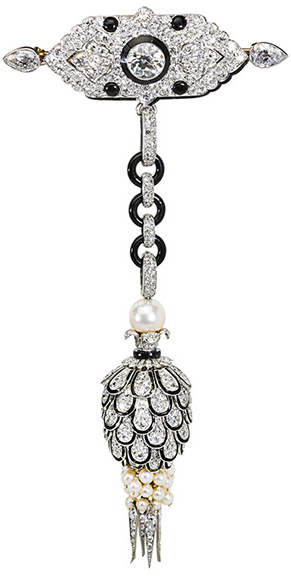
At $514,000 (est. $40,000/60,000), the top lot of the Rago sale was this Cartier, Paris, diamond, saltwater pearl, seed pearl, onyx, and platinum shoulder brooch, designed in 1922. The detachable articulated pinecone-form pendant, with a 9 mm saltwater pearl, seed pearl, and diamond icicle fringe, suspends from seven onyx and diamond platinum links (the largest two are hinged) below a panel brooch in the Persian style. The diamond melee has an approximate total weight of 12 carats. It is inscribed “Cartier #0420” and has French marks for platinum. The brooch was revised and additionally set with an old European-cut diamond weighing approximately 2.90 carats and two pear-shaped diamonds weighing approximately 2.00 carats. Rago.
The strong total sale results ($3,469,375 for 533 lots, 93% sold) were attributed to a number of other factors as well. Churgin said, “The Art Deco pieces came in because…people…had seen what happened with the Putilov pearl.” She was speaking of the December 7, 2014, sale of the largest known near-round natural saltwater pearl in the Putilov brooch, which sold for $813,750 (est. $100,000/500,000). “You continue to build on strength. With an auction, you can’t make a silk purse out of a sow’s ear. But when somebody gives you silk, it’s nice to be able to make that purse—we can make a silk purse out of silk here.”
Communicating with an audience of serious buyers in more than one field is another key to success. “As far as the bidding pool goes, it’s awfully nice to be recognized as Rago Arts and Auction Center and to have all the people who are among our family of bidders.” These are the clients who bid in the 20th-century sales as well as the Arts and Crafts and Lalique sales. “The Lalique pieces that came in from Dora Jane Janson might’ve done fairly well anywhere. But here, all of the jewelry buyers came, and all of the Lalique buyers came—it was a whole auction house effort.”

This signed Cartier Art Deco diamond and platinum 6 3/8" x ½" strap bracelet, with 11 old European-cut diamonds having a total weight of approximately 3.00 carats and 154 old European-cut diamonds and transitional-cut diamonds weighing approximately 13 carats, sold well above the high estimate for $59,375 (est. $10,000/15,000). Rago.
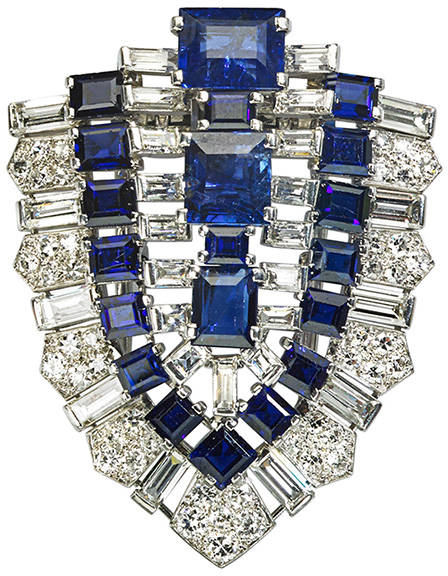
This Cartier, Paris, 1¾" x 1 3/8" diamond and sapphire platinum stepped shield clip, set with square and rectangular step-cut sapphires weighing approximately 10.40 carats and round brilliant-cut and baguette-cut diamonds weighing approximately 5.90 carats, is marked “Cartier OCC, Paris” and sold for $22,500 (est. $5000/7000). Rago.
Another strategy the jewelry department employed was in bringing a selection of pieces from the sale into different venues for buyers to see in person. “We did an extra preview in New York. Normally, we’ve taken a limited preview to the Pier because it’s fun.” Rago took 68 pieces to the Pier, and 135 to 140 to an event at the offices of McMillen, Inc., a decorator in New York City who was “gracious enough to let us throw a pop-up preview in their offices.”
There was a good variety of antique offerings. Churgin said, “It was that kind of a sale. There was great Victorian, and not all of it came in from Dora Jane. Not all of the Art Nouveau, none of the Tiffany did—those were things that just came to us, because it is Rago.” She pointed out a piece by Karl Rothmuller “that came in as an added lot after the catalog went to press. And it sold well because the right people were in attendance.” The circa 1910 Rothmuller Jugendstil opal necklace brooch brought $10,625 (est. $4000/6000).
Churgin said the selection of good material makes for good news. “When you can find the beautiful things, and they’re fresh to the market and rare enough, you’re going to have lots and lots of happy bidders and happy sellers. I do see there’s a lot of midrange material out there—there’s sort of a flood of midrange material, and we see that.”
 When I asked if it is true that this midrange material does not end up in the reserved jewelry auction, Churgin responded in an e-mail, “It is fair to say that we are in the fortunate circumstance of being offered enough interesting jewelry from estates and have enough time between sales that we can be selective. Jewelry specialist Katherine Van Dell and I are passionate about fine and beautiful objects and tend to include in a sale only those things that make our hearts sing. That, coupled with the second-tier venue that is our unreserved jewelry sales, enables us to avoid overloading any sale with redundant material.”
When I asked if it is true that this midrange material does not end up in the reserved jewelry auction, Churgin responded in an e-mail, “It is fair to say that we are in the fortunate circumstance of being offered enough interesting jewelry from estates and have enough time between sales that we can be selective. Jewelry specialist Katherine Van Dell and I are passionate about fine and beautiful objects and tend to include in a sale only those things that make our hearts sing. That, coupled with the second-tier venue that is our unreserved jewelry sales, enables us to avoid overloading any sale with redundant material.”
Churgin said Rago was happy to see that the sale “was a triumph of art over material. You can talk about how much a diamond goes for per carat—you know, $136,000 per carat for a diamond—a new threshold, but we’re selling glass. Basically, plique-à-jour, pâte de verre, and cloisonné are all glass. And what is glass selling for per gram? You know? We’ve sort of hit a new high for glass.”
Sales of reserved and unreserved jewelry will be held in April. Churgin and Van Dell were already busy cataloging lots when I checked in after the December sale. Along with the jewelry, couture, and objects of vertu sales, Rago will be turning the focus to “late 20th-century design jewelry—artisan jewelry— in the 20th-century sales. You’re going to find pieces like that more and more in the 20th-century designs sales.” Look for the 20th-century design auction catalogs online if you are a collector or dealer of jewelry of this period. To see what’s coming up, visit the website (www.ragoarts.com).
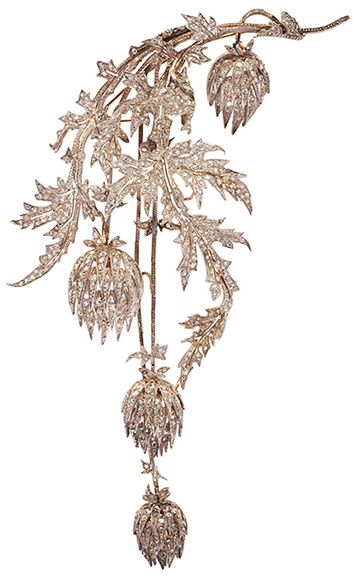
The first lot at the Rago sale was this large circa 1890 Andre Kauffer diamond corsage ornament from the collection of Dora Jane Janson. It was rendered in silver-topped gold frosted with rose-cut diamonds and has maker marks of Francois Fleuret and A. Kauffer, Nancy. The 8" long piece transforms to 6" long by removing the longest Lorraine thistle drop. The corsage ornament came in the original case and sold for $40,625 (est. $9000/12,000). Rago.
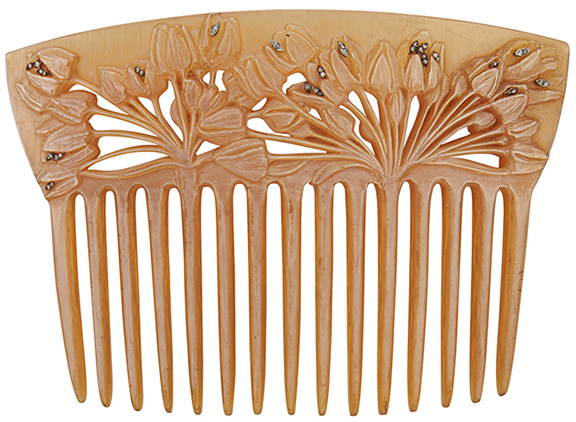
Rene Lalique’s circa 1900 “Ombelles” horn and diamond hair comb was from the collection of Dora Jane Janson. The 3?" x 4¾" comb has the incused mark “Lalique.” I had to look up “incused” because I wasn’t familiar with the term. (And since the program I am writing in kept autocorrecting that word to “infused,” I thought I might not be the only one who wasn’t aware of this word.) The Merriam-Webster dictionary defines incused as “formed by stamping or punching in—used chiefly of old coins or features of their design.” You learn something new every day. The hair comb sold for $33,750 (est. $7000/9000). Rago.
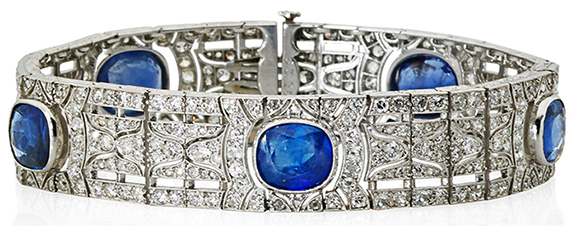
This Art Deco Burma sapphire, diamond, and platinum bracelet with five cushion-cut well-matched blue sapphires has a total weight of 11.5 carats by formula, and the 330 circular brilliant- or rose-cut diamonds have an approximate total weight of 6 carats. Accompanied by an AGL report stating that the five natural, untreated, cushion- and oval mixed-cut blue sapphires measure approximately 9.6 x 8 x 3.57 mm to 8.9 x 7.5 x 3.48 mm and originate from Burma (Myanmar), the unsigned 7" x ½" bracelet brought $46,875 (est. $15,000/25,000). Rago.
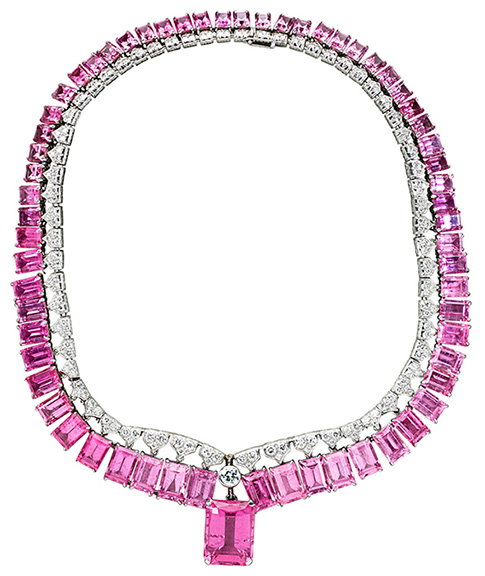
This circa 1956 Nadja Buckley 16" long pink tourmaline, diamond, and platinum fringe necklace with a 1½" drop comprises 62 well-matched graduated rectangular step-cut pink tourmalines, the principal gem weighing 25 carats by formula. The total weight of the tourmalines is approximately 150 carats. The round brilliant-cut diamonds weigh approximately 5.90 carats. It is signed “Nadja Buckley” on the rail of the principal gem setting. The necklace has provenance of Sotheby’s, Geneva, in 1996. It was noted in the catalog that a Van Cleef & Arpels zipper necklace signed by Nadja Buckley had sold on May 19, 2004, at Christie’s in Geneva. This version brought $65,625 (est. $25,000/35,000). Born Countess Nadja Ostrovska, Buckley designed and made jewelry in New York City from 1940 to 1979. Rago.
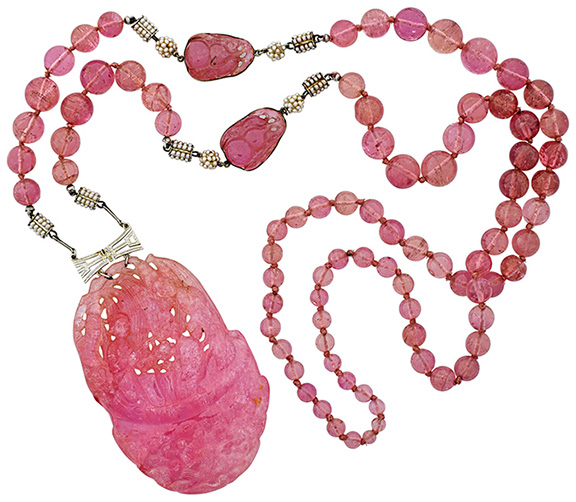
Churgin said this circa 1925 Chinese pierced and carved pink tourmaline necklace “surprised us all.” Depicting courtesans in a boat below willows, the 2¾" long tablet and 32" strand far exceeded the estimate and sold for $30,000 (est. $1200/1800). Rago.
Led by a Heart, Skinner Fine Jewelry Sale Brings $10.75 Million
The Skinner Inc. post-sale press release revealed that “enthusiastic bidders from four continents competed online, by telephone, and in the gallery for the top lots” at Skinner’s fine jewelry auction on December 8, 2015, in Boston. “When the dust had settled, the sale had brought $10.75 million, with almost all of the top lots far exceeding their presale estimates.”
Sale previews in New York and Boston had “generated tremendous excitement” and showcased the offerings to a larger audience.
Highlighting the auction was a collection from the estate of a member of a prominent British American Gilded Age New England family, whose patriarch was “a successful banker who maintained residences in the United States, Great Britain, and France,” according to the Skinner catalog. There had been “rampant speculation that the jewels were once owned by the French royal family,” and this fueled the competitive bidding and strong prices.
Two type IIa diamonds from that collection were features of the sale. According to information passed down through the family, these stones were purchased by the patriarch in the 1880s or 1890s. At the top was a 31.25-carat heart-shape diamond, D color and VVS2 clarity, that realized $3,947,000 (est. $2/3 million). An unmounted 4.07-carat diamond realized $165,000—it had originally been the center of an antique diamond pendant that sold for $104,550. They sold separately but stayed together as the same determined bidder won both.
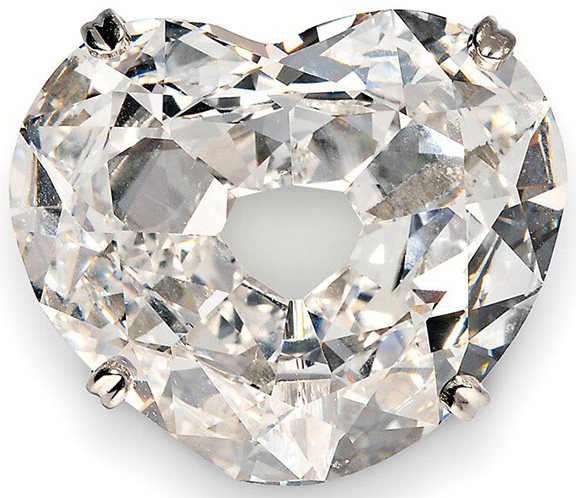
The top lot at the Skinner sale was this 31.25-carat heart-shape diamond measuring approximately 21.27 x 25.05 x 8.02 mm, within a platinum ring mount by Harry Winston. It was accompanied by a GIA report stating that the diamond is D color, VVS2 clarity, and a diamond type classification report stating that the diamond has been determined to be a type IIa. From the collection of prominent British American family, the ring sold soon after Lieberman heard that one of the last phone bidders “standing” was thinking about whether to keep going, and she said, “No thinking! It’s love—come on!” That was a whole lot of love for $3,947,000 (est. $2/3 million). Skinner.
Also from that collection was a natural pearl necklace described by the Swiss Gemological Institute as “rare and exceptional” that sold well above the estimate for $2,211,000 (est. $400,000/600,000).
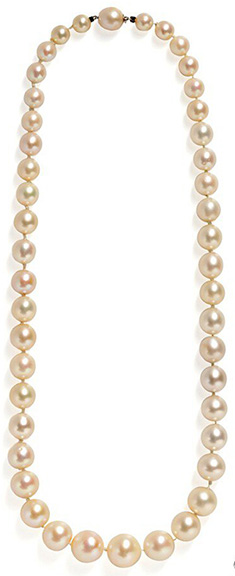
From the collection of a prominent British American family, this important natural pearl necklace is composed of 45 round to roundish drilled white to light cream pearls, partly with rose and green overtones. The pearls graduate in size from approximately 6.85 to 12.80 mm. They were accompanied by an SSEF test report stating that the pearls are natural and that the analyzed properties confirm the authenticity of these saltwater natural pearls. It was offered with an appendix letter describing the rarity and beauty of the “Exceptional Pearl Strand” in detail and sold for well above the high estimate for $2,211,000 (est. $400,000/600,000). Skinner.
Fine diamonds brought strong results—six lots brought over $100,000 each. A fancy blue diamond solitaire weighing 2.65 carats sold for $543,000 (est. $80,000/120,000) to a buyer who bought several other top lots—including an Art Deco platinum, emerald, and diamond ring for $123,000 (est. $20,000/30,000) and the two lots mentioned above, the diamond pendant and the 4.07-carat type IIa diamond.
A companion platinum and diamond riviere with a total diamond weight of approximately 64 carats sold for $123,000 (est. $75,000/125,000).
Fine gemstones were well represented as well, including a Colombian emerald set within an Edwardian brooch that realized $495,000 (est. $50,000/75,000); and from another New England estate, a 5.32-carat cushion-cut Kashmir sapphire sold together with a 14k gold and diamond ring mount for $375,000 (est. $80,000/120,000).
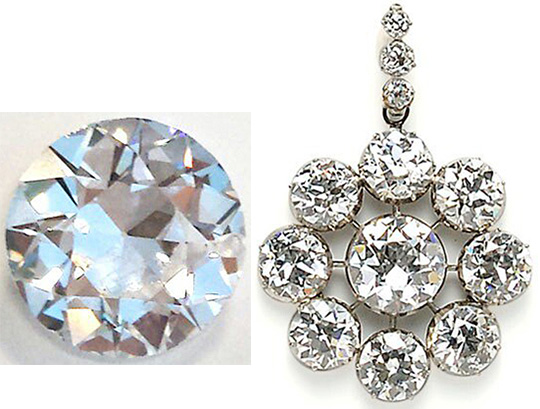
From the collection of a prominent British American family, this unmounted old European-cut diamond measuring approximately 10.62 x 10.76 x 5.93 mm and weighing 4.07 carats was originally part of a diamond pendant. They are shown together at left. Accompanied by a GIA report stating that the diamond is D color, VS2 clarity, and a diamond type classification report stating that the diamond has been determined to be a type IIa, it sold for $165,000 (est. $65,000/75,000). Skinner.
Gloria Lieberman, director emerita of Skinner’s fine jewelry department, was the auctioneer toward the end of the auction, when many of the rarer and more expensive lots sold. Lieberman kept things lively, interesting, and enjoyable. She commented in the post-sale press release, “We are seeing an increase in international buyers seeking out Skinner for jewelry collections from New England families. Often these collections formed in New England in the 19th and 20th centuries are being recognized worldwide for their exquisite quality and fine taste.”
The next jewelry sale will be held in March. Visit the website (www.skinnerinc.com) in February to check out the catalog.
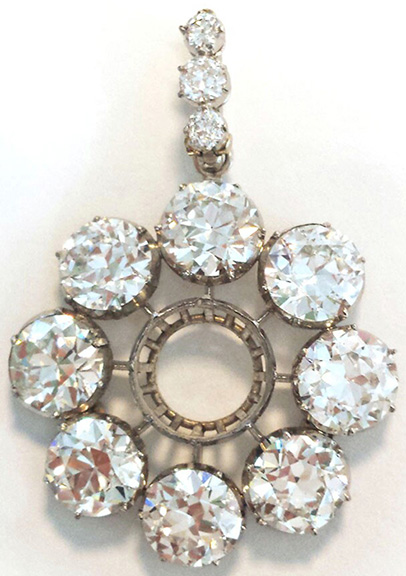
This antique diamond pendant from a prominent British American family, bezel-set with an old European-cut diamond weighing 1.62 carats, an old European-cut diamond weighing 1.52 carats, and six additional old European-cut diamonds with an approximate total weight of 12.00 carats, was accompanied by two GIA reports. The first stated that the 1.62-carat diamond is G color, VS1 clarity, and the second stated that the 1.52-carat diamond is F color, SI1 clarity. It originally had the diamond (shown above right) that sold for $165,000. The pendant sold for $104,550 (est. $45,000/65,000). Skinner.
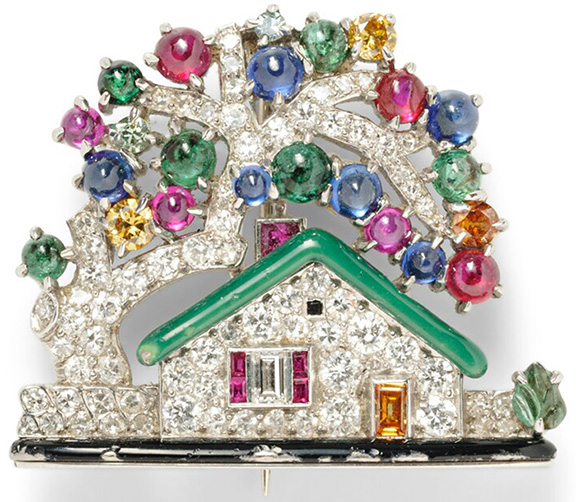
This signed Raymond Yard platinum gem-set “House” brooch was “an iconic piece for them,” according to Lieberman. Designed as a house with a green enamel roof atop a black enamel lawn under a tree set with cabochon and faceted colored stones, it was further set with full- and single-cut diamonds. Lieberman joked to the bidder who won this, “It’s a house! You got it—the house you wanted!” The 1" long brooch realized $36,000 (est. $8000/10,000). Skinner.
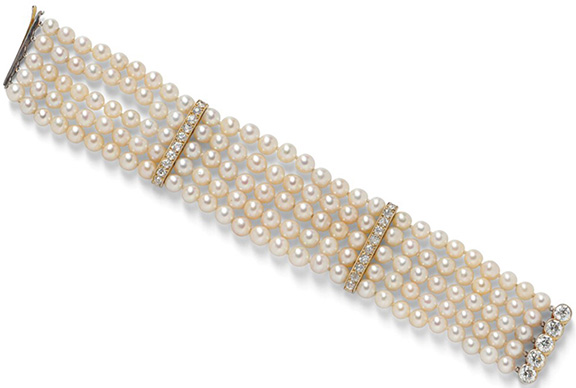
Skinner CEO Karen Keane said there was a lot of interest in this “lovely” 6¾" long natural pearl and diamond bracelet from the collection of a prominent British American family. It was accompanied by a GIA report stating that the pearls are natural with Orient overtone, saltwater, Pinctada species, with no indications of treatment. Comprising 140 pearls ranging in size from approximately 4.83 to 5.65 mm, strung in five rows, with old European-cut diamond spacers having an approximate total weight of 2.65 carats, the bracelet sold for $35,670 (est. $4000/6000). Skinner.
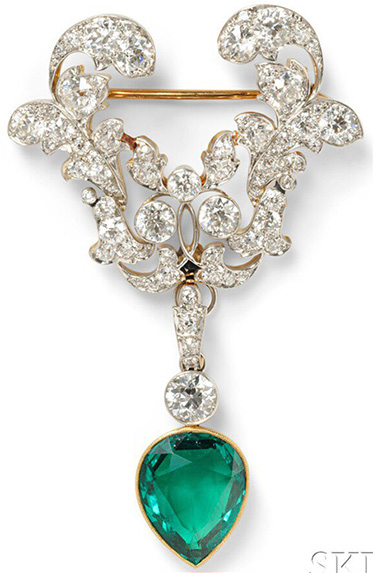
This Edwardian emerald and diamond brooch has a drop set with a pear-shape emerald, measuring approximately 15.40 x 12.10 x 5.22 mm, surmounted by a bezel-set old European-cut diamond, weighing approximately 0.60 carats, and suspended from a scrolling foliate brooch set with old European-cut diamonds (weighing approximately 4.60 carats by formula) in a platinum-topped gold mount. It was accompanied by an AGL document stating that the emerald is classic Colombia, with no clarity enhancement. Bidders ignored the estimate, and it sold for $495,000 (est. $50,000/75,000). Skinner.
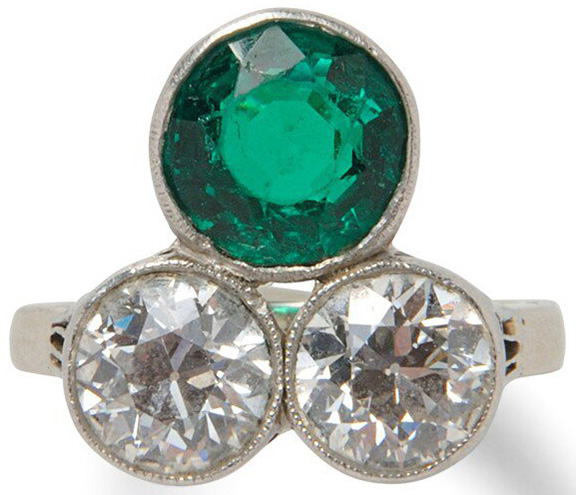
Gloria Lieberman said this Art Deco platinum, emerald, and diamond ring has an “extraordinary little emerald.” The circular-cut emerald is bezel-set and measures approximately 9.10 x 9.00 x 6.43 mm and weighs approximately 2.50 carats. The two old European-cut diamonds weigh approximately 1.30 and 1.40 carats. The ring was accompanied by an AGL document stating that the emerald is of Colombian origin with insignificant traditional clarity enhancement. A couple of lots after this first sold, Gloria Lieberman announced that Skinner had to re-auction it because “someone bid on the wrong emerald.” It sold at the “do-over” for $123,000 (est. $20,000/30,000), a few thousand less than it had moments before, presumably without the aforementioned bidder. Skinner.
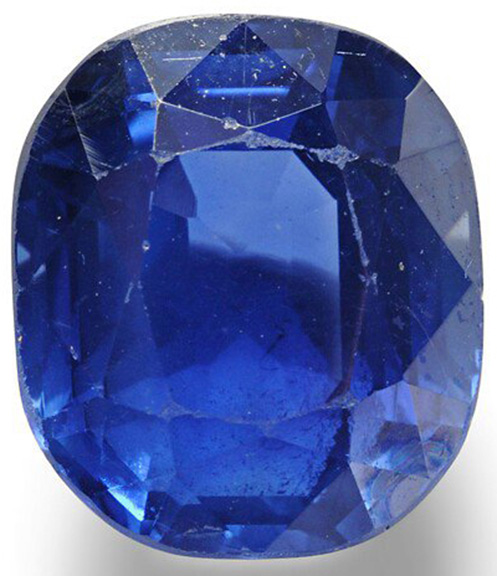
When this unmounted cushion-cut sapphire measuring approximately10.09 x 8.72 x 6.25 mm and weighing 5.32 carats came up to the auction block, initial bids jumped rapidly from $95,000 to $150,000. Accompanied by an AGL document stating that the sapphire is of Kashmir origin, with no gemological evidence of heat, and a Gubelin report stating that the stone is of Kashmir origin with no indications of heating, it sold together with a 14k gold and diamond ring mount for $375,000 (est. $80,000/120,000) to the same buyer who bought several other top lots at the sale, including the Art Deco platinum, emerald, and diamond ring, and the two lots that comprise one jewel (the diamond pendant and 4.07-carat type IIa diamond). Skinner.
Originally published in the February 2016 issue of Maine Antique Digest. © 2016 Maine Antique Digest






